全球行业分类标准(GICS)
- 格式:doc
- 大小:415.50 KB
- 文档页数:16
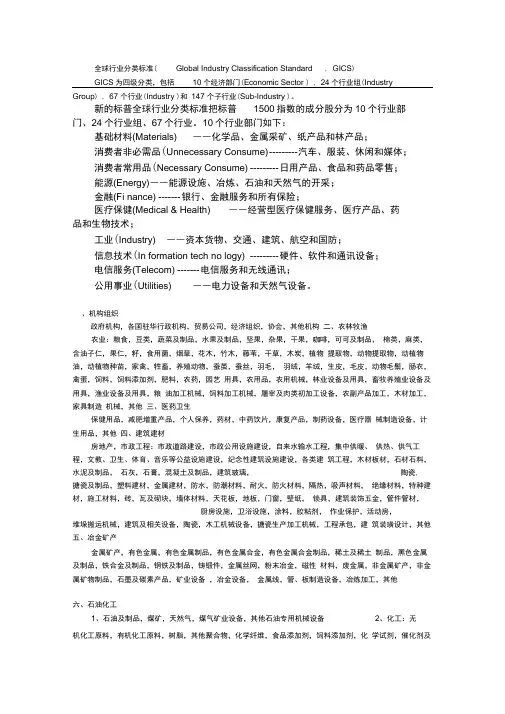
全球行业分类标准( Global Industry Classification Standard , GICS)GICS为四级分类,包括10个经济部门(Economic Sector ) , 24个行业组(IndustryGroup) , 67 个行业(Industry )和147 个子行业(Sub-Industry )。
新的标普全球行业分类标准把标普1500指数的成分股分为10个行业部门、24个行业组、67个行业。
10个行业部门如下:基础材料(Materials) ――化学品、金属采矿、纸产品和林产品;消费者非必需品(Unnecessary Consume) --------- 汽车、服装、休闲和媒体;消费者常用品(Necessary Consume) --------- 日用产品、食品和药品零售;能源(Energy)――能源设施、冶炼、石油和天然气的开采;金融(Fi nance) ------- 银行、金融服务和所有保险;医疗保健(Medical & Health) ――经营型医疗保健服务、医疗产品、药品和生物技术;工业(Industry) ――资本货物、交通、建筑、航空和国防;信息技术(In formation tech no logy) --------- 硬件、软件和通讯设备;电信服务(Telecom) ------- 电信服务和无线通讯;公用事业(Utilities) ――电力设备和天然气设备。
、机构组织政府机构,各国驻华行政机构,贸易公司,经济组织,协会,其他机构二、农林牧渔农业:粮食,豆类,蔬菜及制品,水果及制品,坚果,杂果,干果,咖啡,可可及制品,棉类,麻类,含油子仁,果仁,籽,食用菌,烟草,花木,竹木,藤苇,干草,木炭,植物提取物,动物提取物,动植物油,动植物种苗,家禽,牲畜,养殖动物,蚕茧,蚕丝,羽毛,羽绒,羊绒,生皮,毛皮,动物毛鬃,肠衣,禽蛋,饲料,饲料添加剂,肥料,农药,园艺用具,农用品,农用机械,林业设备及用具,畜牧养殖业设备及用具,渔业设备及用具,粮油加工机械,饲料加工机械,屠宰及肉类初加工设备,农副产品加工,木材加工,家具制造机械,其他三、医药卫生保健用品,减肥增重产品,个人保养,药材,中药饮片,康复产品,制药设备,医疗器械制造设备,计生用品,其他四、建筑建材房地产,市政工程:市政道路建设,市政公用设施建设,自来水输水工程,集中供暖、供热、供气工程,文教、卫生、体育、音乐等公益设施建设,纪念性建筑设施建设,各类建筑工程,木材板材,石材石料,水泥及制品,石灰,石膏,混凝土及制品,建筑玻璃,陶瓷, 搪瓷及制品,塑料建材,金属建材,防水,防潮材料,耐火,防火材料,隔热,吸声材料,绝缘材料,特种建材,施工材料,砖,瓦及砌块,墙体材料,天花板,地板,门窗,壁纸,锁具,建筑装饰五金,管件管材,厨房设施,卫浴设施,涂料,胶粘剂,作业保护,活动房,堆垛搬运机械,建筑及相关设备,陶瓷,木工机械设备,搪瓷生产加工机械,工程承包,建筑装璜设计,其他五、冶金矿产金属矿产,有色金属,有色金属制品,有色金属合金,有色金属合金制品,稀土及稀土制品,黑色金属及制品,铁合金及制品,钢铁及制品,铸锻件,金属丝网,粉末冶金,磁性材料,废金属,非金属矿产,非金属矿物制品,石墨及碳素产品,矿业设备,冶金设备,金属线,管、板制造设备,冶炼加工,其他六、石油化工1、石油及制品,煤矿,天然气,煤气矿业设备,其他石油专用机械设备2、化工:无机化工原料,有机化工原料,树脂,其他聚合物,化学纤维,食品添加剂,饲料添加剂,化学试剂,催化剂及化学助剂,日用化学品,香料,香精,染料,颜料,涂料,胶粘剂,火工产品,油墨,塑料及制品,橡胶及制品,玻璃及制品,实验室用品,仪器,仪表,塑料生产加工机械,橡胶生产加工机械,玻璃生产加工机械,化工设备,化工废料,化工产品设计加工,其他七、水利水电水利、火力发电设备,水利、防洪工程及用品,河道疏浚工程,大坝、水库、闸门、泻洪工程,农田水利工程,江河、湖泊治理工程,电力工程,电力、太阳能及再生能源,其他水利水电设备,其他水利水电设施八、交通运输1、轮胎,汽车:轿车,越野汽车,吉普车,卡车,载客汽车,旅行面包车,公共汽车地,微型客车,其它载客汽车,专用汽车,工程汽车,工具汽车,消防车,警车,救护车,通讯和广播用车,皮卡,洒水车,道路清扫车,垃圾车,其他专用汽车,电车,汽车配件,摩托车及配件,专用车辆,二手汽摩,汽摩附属及相关产品,停车场,加油站设备,汽车保养,交通安全,汽摩产品制造设备,船只,飞机,其他交通工具,其它;2、自行车,三轮车及配件,铁路,地铁用设备器材,船舶及配件,电梯,缆车及配件,飞行器及配件,集装箱,二手交通产品及用具,轮胎,废气处理设施,交通安全设施,运输、仓储,其他3、机场、航空工程,港口工程,铁路工程,公路、桥梁、涵洞。
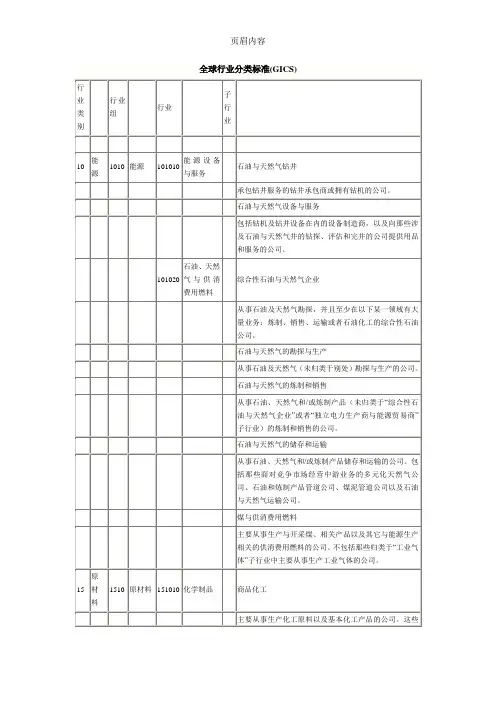
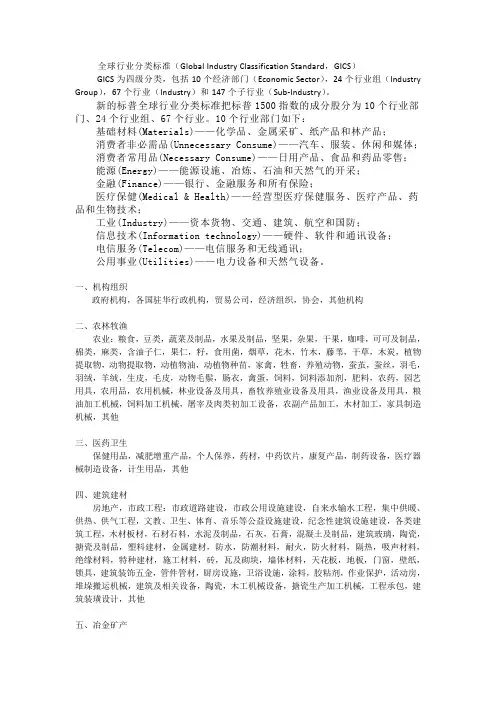
全球行业分类标准(Global Industry Classification Standard,GICS)GICS为四级分类,包括10个经济部门(Economic Sector),24个行业组(Industry Group),67个行业(Industry)和147个子行业(Sub-Industry)。
新的标普全球行业分类标准把标普1500指数的成分股分为10个行业部门、24个行业组、67个行业。
10个行业部门如下:基础材料(Materials)——化学品、金属采矿、纸产品和林产品;消费者非必需品(Unnecessary Consume)——汽车、服装、休闲和媒体;消费者常用品(Necessary Consume)——日用产品、食品和药品零售;能源(Energy)——能源设施、冶炼、石油和天然气的开采;金融(Finance)——银行、金融服务和所有保险;医疗保健(Medical & Health)——经营型医疗保健服务、医疗产品、药品和生物技术;工业(Industry)——资本货物、交通、建筑、航空和国防;信息技术(Information technology)——硬件、软件和通讯设备;电信服务(Telecom)——电信服务和无线通讯;公用事业(Utilities)——电力设备和天然气设备。
一、机构组织政府机构,各国驻华行政机构,贸易公司,经济组织,协会,其他机构二、农林牧渔农业:粮食,豆类,蔬菜及制品,水果及制品,坚果,杂果,干果,咖啡,可可及制品,棉类,麻类,含油子仁,果仁,籽,食用菌,烟草,花木,竹木,藤苇,干草,木炭,植物提取物,动物提取物,动植物油,动植物种苗,家禽,牲畜,养殖动物,蚕茧,蚕丝,羽毛,羽绒,羊绒,生皮,毛皮,动物毛鬃,肠衣,禽蛋,饲料,饲料添加剂,肥料,农药,园艺用具,农用品,农用机械,林业设备及用具,畜牧养殖业设备及用具,渔业设备及用具,粮油加工机械,饲料加工机械,屠宰及肉类初加工设备,农副产品加工,木材加工,家具制造机械,其他三、医药卫生保健用品,减肥增重产品,个人保养,药材,中药饮片,康复产品,制药设备,医疗器械制造设备,计生用品,其他四、建筑建材房地产,市政工程:市政道路建设,市政公用设施建设,自来水输水工程,集中供暖、供热、供气工程,文教、卫生、体育、音乐等公益设施建设,纪念性建筑设施建设,各类建筑工程,木材板材,石材石料,水泥及制品,石灰,石膏,混凝土及制品,建筑玻璃,陶瓷,搪瓷及制品,塑料建材,金属建材,防水,防潮材料,耐火,防火材料,隔热,吸声材料,绝缘材料,特种建材,施工材料,砖,瓦及砌块,墙体材料,天花板,地板,门窗,壁纸,锁具,建筑装饰五金,管件管材,厨房设施,卫浴设施,涂料,胶粘剂,作业保护,活动房,堆垛搬运机械,建筑及相关设备,陶瓷,木工机械设备,搪瓷生产加工机械,工程承包,建筑装璜设计,其他五、冶金矿产金属矿产,有色金属,有色金属制品,有色金属合金,有色金属合金制品,稀土及稀土制品,黑色金属及制品,铁合金及制品,钢铁及制品,铸锻件,金属丝网,粉末冶金,磁性材料,废金属,非金属矿产,非金属矿物制品,石墨及碳素产品,矿业设备,冶金设备,金属线,管、板制造设备,冶炼加工,其他六、石油化工1、石油及制品,煤矿,天然气,煤气矿业设备,其他石油专用机械设备2、化工:无机化工原料,有机化工原料,树脂,其他聚合物,化学纤维,食品添加剂,饲料添加剂,化学试剂,催化剂及化学助剂,日用化学品,香料,香精,染料,颜料,涂料,胶粘剂,火工产品,油墨,塑料及制品,橡胶及制品,玻璃及制品,实验室用品,仪器,仪表,塑料生产加工机械,橡胶生产加工机械,玻璃生产加工机械,化工设备,化工废料,化工产品设计加工,其他七、水利水电水利、火力发电设备,水利、防洪工程及用品,河道疏浚工程,大坝、水库、闸门、泻洪工程,农田水利工程,江河、湖泊治理工程,电力工程,电力、太阳能及再生能源,其他水利水电设备,其他水利水电设施八、交通运输1、轮胎,汽车:轿车,越野汽车,吉普车,卡车,载客汽车,旅行面包车,公共汽车地,微型客车,其它载客汽车,专用汽车,工程汽车,工具汽车,消防车,警车,救护车,通讯和广播用车,皮卡,洒水车,道路清扫车,垃圾车,其他专用汽车,电车,汽车配件,摩托车及配件,专用车辆,二手汽摩,汽摩附属及相关产品,停车场,加油站设备,汽车保养,交通安全,汽摩产品制造设备,船只,飞机,其他交通工具,其它;2、自行车,三轮车及配件,铁路,地铁用设备器材,船舶及配件,电梯,缆车及配件,飞行器及配件,集装箱,二手交通产品及用具,轮胎,废气处理设施,交通安全设施,运输、仓储,其他3、机场、航空工程,港口工程,铁路工程,公路、桥梁、涵洞。
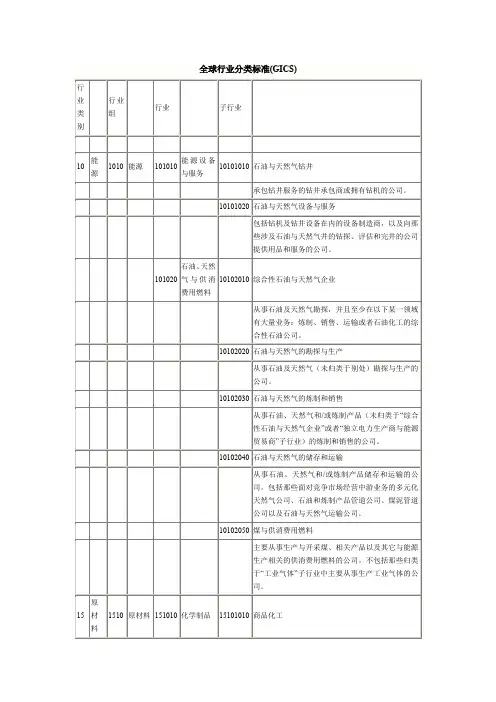
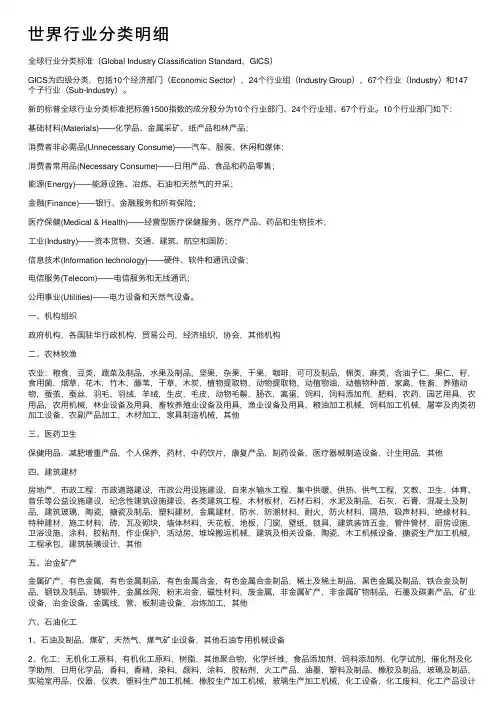
世界⾏业分类明细全球⾏业分类标准(Global Industry Classification Standard,GICS)GICS为四级分类,包括10个经济部门(Economic Sector),24个⾏业组(Industry Group),67个⾏业(Industry)和147个⼦⾏业(Sub-Industry)。
新的标普全球⾏业分类标准把标普1500指数的成分股分为10个⾏业部门、24个⾏业组、67个⾏业。
10个⾏业部门如下:基础材料(Materials)——化学品、⾦属采矿、纸产品和林产品;消费者⾮必需品(Unnecessary Consume)——汽车、服装、休闲和媒体;消费者常⽤品(Necessary Consume)——⽇⽤产品、⾷品和药品零售;能源(Energy)——能源设施、冶炼、⽯油和天然⽓的开采;⾦融(Finance)——银⾏、⾦融服务和所有保险;医疗保健(Medical & Health)——经营型医疗保健服务、医疗产品、药品和⽣物技术;⼯业(Industry)——资本货物、交通、建筑、航空和国防;信息技术(Information technology)——硬件、软件和通讯设备;电信服务(Telecom)——电信服务和⽆线通讯;公⽤事业(Utilities)——电⼒设备和天然⽓设备。
⼀、机构组织政府机构,各国驻华⾏政机构,贸易公司,经济组织,协会,其他机构⼆、农林牧渔农业:粮⾷,⾖类,蔬菜及制品,⽔果及制品,坚果,杂果,⼲果,咖啡,可可及制品,棉类,⿇类,含油⼦仁,果仁,籽,⾷⽤菌,烟草,花⽊,⽵⽊,藤苇,⼲草,⽊炭,植物提取物,动物提取物,动植物油,动植物种苗,家禽,牲畜,养殖动物,蚕茧,蚕丝,⽻⽑,⽻绒,⽺绒,⽣⽪,⽑⽪,动物⽑鬃,肠⾐,禽蛋,饲料,饲料添加剂,肥料,农药,园艺⽤具,农⽤品,农⽤机械,林业设备及⽤具,畜牧养殖业设备及⽤具,渔业设备及⽤具,粮油加⼯机械,饲料加⼯机械,屠宰及⾁类初加⼯设备,农副产品加⼯,⽊材加⼯,家具制造机械,其他三、医药卫⽣保健⽤品,减肥增重产品,个⼈保养,药材,中药饮⽚,康复产品,制药设备,医疗器械制造设备,计⽣⽤品,其他四、建筑建材房地产,市政⼯程:市政道路建设,市政公⽤设施建设,⾃来⽔输⽔⼯程,集中供暖、供热、供⽓⼯程,⽂教、卫⽣、体育、⾳乐等公益设施建设,纪念性建筑设施建设,各类建筑⼯程,⽊材板材,⽯材⽯料,⽔泥及制品,⽯灰,⽯膏,混凝⼟及制品,建筑玻璃,陶瓷,搪瓷及制品,塑料建材,⾦属建材,防⽔,防潮材料,耐⽕,防⽕材料,隔热,吸声材料,绝缘材料,特种建材,施⼯材料,砖,⽡及砌块,墙体材料,天花板,地板,门窗,壁纸,锁具,建筑装饰五⾦,管件管材,厨房设施,卫浴设施,涂料,胶粘剂,作业保护,活动房,堆垛搬运机械,建筑及相关设备,陶瓷,⽊⼯机械设备,搪瓷⽣产加⼯机械,⼯程承包,建筑装璜设计,其他五、冶⾦矿产⾦属矿产,有⾊⾦属,有⾊⾦属制品,有⾊⾦属合⾦,有⾊⾦属合⾦制品,稀⼟及稀⼟制品,⿊⾊⾦属及制品,铁合⾦及制品,钢铁及制品,铸锻件,⾦属丝⽹,粉末冶⾦,磁性材料,废⾦属,⾮⾦属矿产,⾮⾦属矿物制品,⽯墨及碳素产品,矿业设备,冶⾦设备,⾦属线,管、板制造设备,冶炼加⼯,其他六、⽯油化⼯1、⽯油及制品,煤矿,天然⽓,煤⽓矿业设备,其他⽯油专⽤机械设备2、化⼯:⽆机化⼯原料,有机化⼯原料,树脂,其他聚合物,化学纤维,⾷品添加剂,饲料添加剂,化学试剂,催化剂及化学助剂,⽇⽤化学品,⾹料,⾹精,染料,颜料,涂料,胶粘剂,⽕⼯产品,油墨,塑料及制品,橡胶及制品,玻璃及制品,实验室⽤品,仪器,仪表,塑料⽣产加⼯机械,橡胶⽣产加⼯机械,玻璃⽣产加⼯机械,化⼯设备,化⼯废料,化⼯产品设计加⼯,其他七、⽔利⽔电⽔利、⽕⼒发电设备,⽔利、防洪⼯程及⽤品,河道疏浚⼯程,⼤坝、⽔库、闸门、泻洪⼯程,农⽥⽔利⼯程,江河、湖泊治理⼯程,电⼒⼯程,电⼒、太阳能及再⽣能源,其他⽔利⽔电设备,其他⽔利⽔电设施⼋、交通运输1、轮胎,汽车:轿车,越野汽车,吉普车,卡车,载客汽车,旅⾏⾯包车,公共汽车地,微型客车,其它载客汽车,专⽤汽车,⼯程汽车,⼯具汽车,消防车,警车,救护车,通讯和⼴播⽤车,⽪卡,洒⽔车,道路清扫车,垃圾车,其他专⽤汽车,电车,汽车配件,摩托车及配件,专⽤车辆,⼆⼿汽摩,汽摩附属及相关产品,停车场,加油站设备,汽车保养,交通安全,汽摩产品制造设备,船只,飞机,其他交通⼯具,其它;2、⾃⾏车,三轮车及配件,铁路,地铁⽤设备器材,船舶及配件,电梯,缆车及配件,飞⾏器及配件,集装箱,⼆⼿交通产品及⽤具,轮胎,废⽓处理设施,交通安全设施,运输、仓储,其他3、机场、航空⼯程,港⼝⼯程,铁路⼯程,公路、桥梁、涵洞。
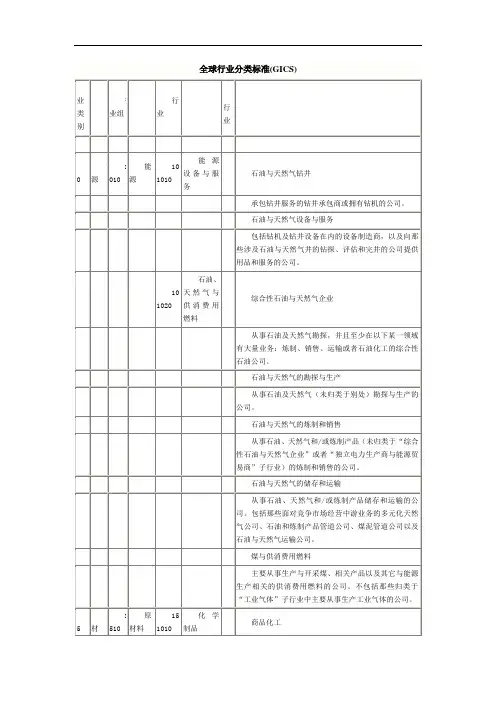
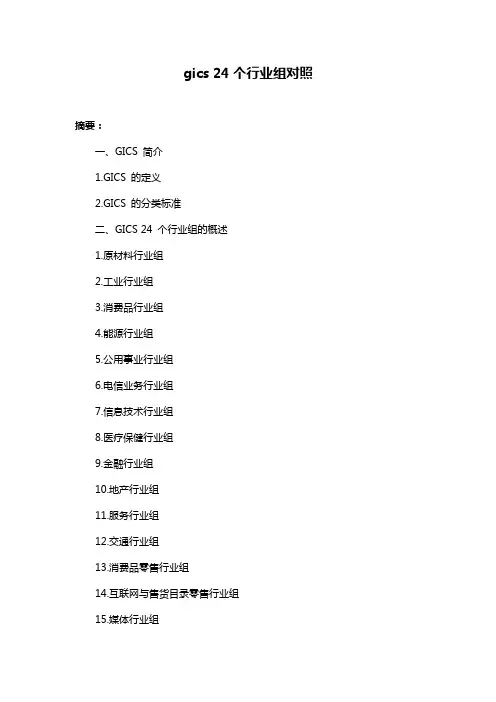
gics 24个行业组对照摘要:一、GICS 简介1.GICS 的定义2.GICS 的分类标准二、GICS 24 个行业组的概述1.原材料行业组2.工业行业组3.消费品行业组4.能源行业组5.公用事业行业组6.电信业务行业组7.信息技术行业组8.医疗保健行业组9.金融行业组10.地产行业组11.服务行业组12.交通行业组13.消费品零售行业组14.互联网与售货目录零售行业组15.媒体行业组16.通信设备行业组17.半导体行业组18.软件与服务行业组19.硬件与设备行业组20.航天与国防行业组21.电子行业组22.环保行业组23.建筑产品行业组24.建筑与工程行业组三、GICS 行业组在投资中的应用1.行业组与投资策略的关系2.如何利用GICS 行业组进行投资分析3.GICS 行业组在风险管理中的作用正文:【GICS 简介】GICS(Global Industry Classification Standard)是全球行业分类标准,由摩根士丹利资本国际公司(MSCI)与标准普尔公司(S&P)共同制定。
GICS 将全球行业划分为24 个行业组,以帮助投资者更好地了解和分析各个行业的发展趋势、竞争状况以及投资机会。
【GICS 24 个行业组的概述】1.原材料行业组:包括金属与采矿、化肥与化工等原材料生产商。
2.工业行业组:涵盖航空航天、建筑产品、建筑与工程等制造商。
3.消费品行业组:包括食品、饮料、烟草、纺织品、服装、家居用品等消费品生产商。
4.能源行业组:涉及石油、天然气、电力等能源供应商。
5.公用事业行业组:主要指水、电、气等公共事业服务提供商。
6.电信业务行业组:包括固定电话、移动电话、互联网服务等电信运营商。
7.信息技术行业组:涵盖软件、硬件、半导体等信息技术产品与服务提供商。
8.医疗保健行业组:涉及制药、生物技术、医疗设备等医疗保健产品与服务提供商。
9.金融行业组:包括银行、保险、证券等金融机构。
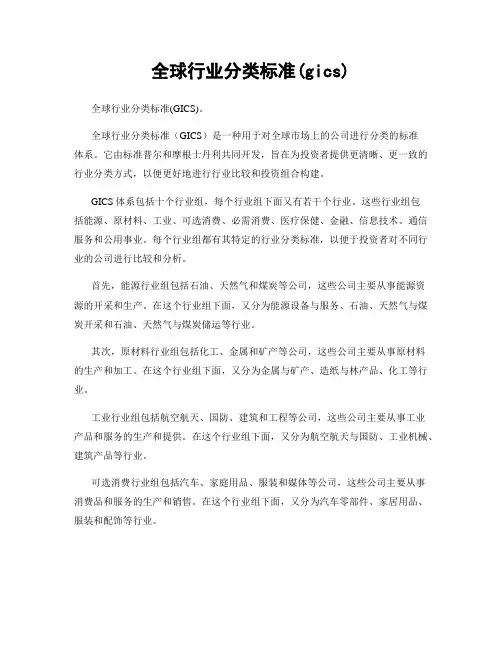
全球行业分类标准(gics)全球行业分类标准(GICS)。
全球行业分类标准(GICS)是一种用于对全球市场上的公司进行分类的标准体系。
它由标准普尔和摩根士丹利共同开发,旨在为投资者提供更清晰、更一致的行业分类方式,以便更好地进行行业比较和投资组合构建。
GICS体系包括十个行业组,每个行业组下面又有若干个行业。
这些行业组包括能源、原材料、工业、可选消费、必需消费、医疗保健、金融、信息技术、通信服务和公用事业。
每个行业组都有其特定的行业分类标准,以便于投资者对不同行业的公司进行比较和分析。
首先,能源行业组包括石油、天然气和煤炭等公司,这些公司主要从事能源资源的开采和生产。
在这个行业组下面,又分为能源设备与服务、石油、天然气与煤炭开采和石油、天然气与煤炭储运等行业。
其次,原材料行业组包括化工、金属和矿产等公司,这些公司主要从事原材料的生产和加工。
在这个行业组下面,又分为金属与矿产、造纸与林产品、化工等行业。
工业行业组包括航空航天、国防、建筑和工程等公司,这些公司主要从事工业产品和服务的生产和提供。
在这个行业组下面,又分为航空航天与国防、工业机械、建筑产品等行业。
可选消费行业组包括汽车、家庭用品、服装和媒体等公司,这些公司主要从事消费品和服务的生产和销售。
在这个行业组下面,又分为汽车零部件、家居用品、服装和配饰等行业。
必需消费行业组包括食品、饮料、零售和个人用品等公司,这些公司主要从事必需品和服务的生产和销售。
在这个行业组下面,又分为食品与饮料、零售商、个人与家庭用品等行业。
医疗保健行业组包括制药、生物技术、医疗器械和服务等公司,这些公司主要从事医疗保健产品和服务的生产和提供。
在这个行业组下面,又分为制药、生物技术、医疗器械和服务等行业。
金融行业组包括银行、保险、房地产和资本市场等公司,这些公司主要从事金融服务和资本运作。
在这个行业组下面,又分为银行、多元金融、房地产等行业。
信息技术行业组包括软件、硬件和半导体等公司,这些公司主要从事信息技术产品和服务的研发和生产。
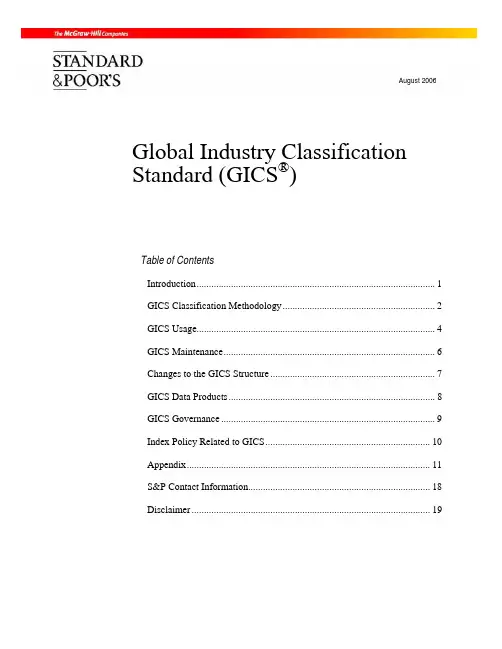
August 2006Global Industry Classification Standard (GICS®)Table of ContentsIntroduction (1)GICS Classification Methodology (2)GICS Usage (4)GICS Maintenance (6)Changes to the GICS Structure (7)GICS Data Products (8)GICS Governance (9)Index Policy Related to GICS (10)Appendix (11)S&P Contact Information (18)Disclaimer (19)IntroductionIn 1999, Standard & Poor’s and MSCI/Barra jointly developed the Global Industry Classification Standard (GICS®) to establish a global standard for categorizing companies into sectors and industries. GICS was developed in response to the global financial community’s need for one complete, consistent set of global sector and industry definitions, thereby enabling asset owners, asset managers and investment research specialists to make seamless company, sector and industry comparisons across countries, regions, and globally.HighlightsGICS has become an industry model widely recognized by market participants worldwide. It sets a foundation for the creation of replicable, custom-tailored portfolios and enables meaningful comparisons of sectors and industries globally.GICS was developed and is maintained by two leading global index providers. It has been specifically designed to classify companies globally – in both developed and developing economies.The GICS methodology has been commonly accepted as an industry analysis framework for investment research, portfolio management and asset allocation. The GICS classification system currently consists of 10 sectors, 24 industry groups, 67 industries and 147 sub-industries. The GICS sectors are:• Consumer Discretionary• Consumer Staples• Energy• Financials• Health Care• Industrials• Information Technology• Materials• Telecommunication Services• UtilitiesGICS was designed to classify a company according to its principal business activity. To make this determination, Standard & Poor’s and MSCI use revenues as a key measure of a company’s business activity. Earnings and market perception, however, are also recognized as important and relevant information for classification purposes and are taken into account during the review process.GICS Classification MethodologyAbout GICSGICS is designed to meet the needs of the investment community for a classification system that reflects a company’s primary business model as determined by its financial performance. Many other systems group companies into classifications designed for tracking GDP and the economy rather than company performance. Over 34,000 active, publicly traded companies globally are currently classified and maintained by S&P and MSCI according to the GICS methodology.GICS StructureGICS is a four-tiered, hierarchical industry classification system:• 10 Sectors• 24 Industry Groups• 67 Industries• 147 Sub-IndustriesGICS classifications can be presented in text or numeric format. The full GICS classification for each company is an 8-digit code with text description. The hierarchical design of the 8-digit coding system allows for easy transition between GICS tiers.Examples:Sector: Consumer Discretionary (GICS code: 25)Industry Group: Consumer Services (GICS code: 2530)Industry: Hotels, Restaurants & Leisure (GICS code: 253010)Sub-industry: Casinos & Gaming (GICS code: 25301010)Sector: Financials (GICS code: 40)Industry Group: Diversified Financials (GICS code: 4020)Industry: Capital Markets (GICS code: 402030)Sub-industry: Investment Banking & Brokerage (GICS code: 40203020)GICS Compliant IndicesStandard & Poor’s has long been a leading provider of indices used by the international financial markets for portfolio analysis and asset management. By developing indices using the GICS structure, S&P presents a powerful family of sector-based indices that offer a global, consistent set of benchmarks.For more information on GICS-based index products at Standard & Poor’s, please visit our Web site at .GICS enables both S&P and any index provider who adopts the system to develop competing sector indices and index products from a common global standard.An index that is GICS-compliant is one that is derived, bottom-up, using GICS as the industry classification methodology -- specifically the unique, company-to-issue level classification as determined by S&P and MSCI.GICS AssignmentsStandard & Poor’s and MSCI jointly assign a company to a single GICS sub-industry according to the definition of its principal business activity as determined by the two companies. Revenues are a significant factor in determining principal business activity; however, earnings and market perception are also important criteria for classification.If a company’s subsidiary files separate financials to its reporting government agency, that subsidiary will be considered a separate entity and classified independently under the GICS methodology. Equity securities or issues directly linked to a company will have the same classification as the company.GICS UsageGICS Usage at S&PGICS is the official Standard & Poor's industry classification system. Most Standard & Poor's products that include an industry classification system use the GICS structure.All companies in the Standard & Poor’s global family of indices have been classified according to the GICS structure. Standard & Poor’s indices and sub-indices are designed to reflect the sectoral composition of the broad markets they represent. Many of the broad S&P indices are broken down into sector- and/or industry-level indices to provide performance measurements across these markets. The sector weights of an S&P index provide the financial community with a useful benchmark of sectors representation within that market.While Standard & Poor’s equity indices have set the foundation for GICS and GICS usage, many other S&P products incorporate GICS into their products. These include, but are not limited to:• S&P Global Indices• Stock Reports• Sector Scorecards• Compustat• Research Insight• Analysts’ Handbook• Capital IQ• CreditPro, Ratings Direct, and RatingsXpressGICS Usage in the MarketInvestors use GICS and all related industry indices and data across the full spectrum of equity market investing – including asset management, sector research, portfolio strategy, peer analysis, and client account reporting. The use of GICS enables market participants to identify and analyze a customized group of companies from a common global standard. The use of this global standard helps strategists, analysts, and investors compare companies outside of their local markets and attract capital into local markets when comparing stocks within the same industry. GICS helps market participants determine whether stock movements are locally based or are part of a broader global trend.The GICS methodology has been widely accepted as an industry analysis framework for investment research, portfolio management and asset allocation. Its universal approach to industries worldwide has contributed to transparency and efficiency in the investment process, and the GICS methodology supports the trend towards sector-based investing.GICS defines peer groups tightly and avoids grouping unlike companies together. Four classification levels allow for more customization and targeting in portfolio, index and derivative product construction.Investors use GICS and all related S&P industry indices and data across the full spectrum of equity market management – including asset management, sector research, portfolio strategy, peer analysis, and client account reporting. The use of GICS enables market participants to identify and analyze a customized group of companies from a common global standard.Market participants currently using the GICS structure include buy-side portfolio managers, institutional and retail brokerage firms, custodians, universities, consultants, and a variety of data distributors.GICS MaintenanceGICS ReviewsCompanies are reviewed annually at a minimum. Companies are also under constant surveillance for corporate actions.In general, a GICS code will change whenever there is a major corporate action that redefines a company's primary line of business. At a minimum, annual reviews are conducted to ensure that a company has not redefined its line of business through a series of smaller events.GICS reviews will also occur upon client request through the use of the GICS email box, spgics@.GICS Structure ReviewStandard & Poor’s and MSCI review the GICS structure on an annual basis. Frequently this is done through an open consultation. The objective is to ensure that the GICS structure continues to accurately represent the global equity markets, and thereby, enables asset owners, asset managers and investment research specialists to make seamless global comparisons by industry.Changes to the GICS StructureThe four-level GICS structure accurately reflects equities in today’s global investment environment, yet is flexible enough to capture tomorrow’s developments. The eight-digit GICS coding system is designed to adapt easily to the changing investmentworld. As the global economy changes, sectors, industry group, industries and sub-industries can be added or divided.The chronology of the GICS structures is as follows:EventDate GICSAugust 1999 GICS introduced. GICS comprised of 10 sectors, 23 industry groups, 59 industries and 123 sub-industries.March 2002 The total number of sub-industries in the GICS structure reduced to 122 from 123. Name and description changes to other GICS categories.GICS comprised of 10 sectors, 23 industry groups, 59 industries and 122sub-industries.April 2003 Changes included the creation of new industry groups, industries and sub-industries, the merger of some existing sub-industries andsignificant name and definition changes to others. GICS comprised of10 sectors, 24 industry groups, 62 industries and 132 sub-industries. April 2004 Changes limited to definition changes for some of the GICS sub-industries. GICS comprised of 10 sectors, 24 industry groups, 62industries and 132 sub-industries.April 2005 Changes included renaming and redefining one industry group, creating two industries and seven sub-industries, and making significant nameand definition changes to others. GICS comprised of 10 sectors, 24industry groups, 64 industries and 139 sub-industries.April 2006 Changes included renaming one industry group, creating four newindustries and ten new sub-industries. Changes also includeddiscontinuing one industry and two sub-industries, and making nameand definition changes to others. GICS comprised of 10 sectors, 24industry groups, 67 industries and 147 sub-industries.Detailed information on the changes to the GICS structures can be found onStandard & Poor’s Web site at .GICS Data ProductsGICS DirectGICS Direct SM, a joint product of Standard & Poor’s and MSCI, was introduced in 2001. GICS Direct provides industry classifications for more then 34,000 active companies and 38,000 active securities. S&P and MSCI estimate that GICS Direct covers approximately 98% of the world’s equity market capitalization.GICS HistoryStandard & Poor's GICS History is a valuable tool for statistical analysis, back-testing and historic sector performance attribution. GICS History provides historical classifications on over 25,000 active and inactive U.S. companies, Canadian companies, and ADRsFor more information on GICS Direct and GICS History, please visitStandard & Poor’s Web site .GICS GovernanceGICS Methodology CommitteeThe GICS methodology and structure fall under the overall supervision of the GICS Operations Committee, with members from both S&P and MSCI. The Committee will from time to time consult the financial markets in order to keep the methodology current and relevant.Standard & Poor’s and MSCI considers information about changes to the GICS structure and related matters to be potentially market moving and material. Therefore, all Committee discussions are confidential.Index Policy Related to GICSAnnouncementsAnnouncements of GICS changes to companies in S&P indices follow the guidelines of the index methodologies.Please refer to the individual index methodologies for treatment of GICS classification changes.AppendixThe Current GICS StructureS&P Contact InformationIndex ManagementDavid M. Blitzer, Ph.D. – Managing Director & Chairman of the Index Committee david_blitzer@ 1 212 438 3907 Maureen Maitland – Vice President, Index Analysis and Managementmaureen_maitland@standardandpoors 1 212 438 1178 Media RelationsDavid Guarino – Communicationsdave_guarino@ 1 212 438 1471 Sales and MarketingNorth AmericaNew YorkWendy Chan 1 212 438 4080Maureen O’Shea 1 212 438 2046 TorontoJasmit Bhandal 1 416 507 3203Tony North 1 416 507 3204 EuropeParisChristopher O’Brien 33 (0) 1 40 75 77 91 LondonSusan Fagg 44 (0) 20 7176 8388 AsiaHong KongJean Park 852 2841 1032 BeijingAndrew Webb 8610 6535 2919 TokyoSeiichiro Uchi 81 3 4550 8568 SydneyJason Hill 61 2 9255 9872DisclaimerThe report is published by Standard & Poor’s, 55 Water Street, New York, NY 10041. Copyright © 2006. Standard & Poor’s is a division of The McGraw-Hill Companies, Inc. All rights reserved. Standard & Poor’s does not undertake to advise you of changes in the information contained in this report.These materials have been prepared solely for informational purposes based upon information generally available to the public from sources believed to be reliable. Standard & Poor’s makes no representation with respect to the accuracy or completeness of these materials, the content of which may change without notice. Standard & Poor’s disclaims any and all liability relating to these materials and makes no express or implied representations or warranties concerning the accuracy or completeness of the report.No portion of this publication may be reproduced in any format or by any means including electronically or mechanically, by photocopying, recording or by any information storage or retrieval system, or by any other form or manner whatsoever, without the prior written consent of Standard & Poor’s.Analytic services and products provided by Standard & Poor’s are the result of separate activities designed to preserve the independence and objectivity of each analytic process. Standard & Poor’s has established policies and procedures to maintain the confidentiality of non-public information received during each analytic process.。
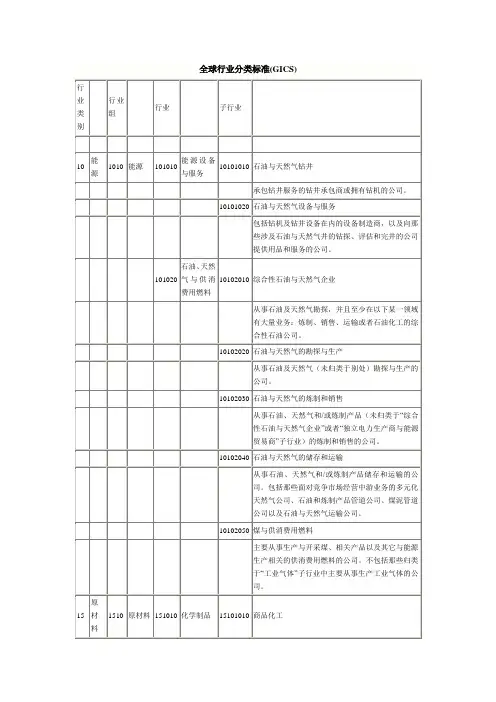
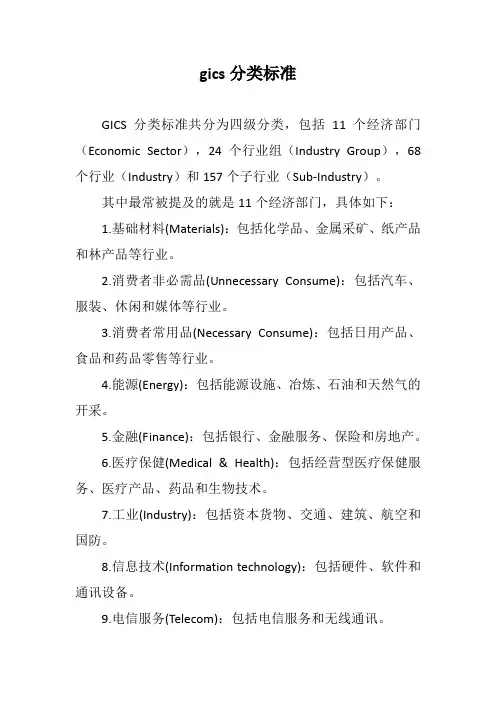
gics分类标准
GICS分类标准共分为四级分类,包括11个经济部门(Economic Sector),24个行业组(Industry Group),68个行业(Industry)和157个子行业(Sub-Industry)。
其中最常被提及的就是11个经济部门,具体如下:
1.基础材料(Materials):包括化学品、金属采矿、纸产品和林产品等行业。
2.消费者非必需品(Unnecessary Consume):包括汽车、服装、休闲和媒体等行业。
3.消费者常用品(Necessary Consume):包括日用产品、食品和药品零售等行业。
4.能源(Energy):包括能源设施、冶炼、石油和天然气的开采。
5.金融(Finance):包括银行、金融服务、保险和房地产。
6.医疗保健(Medical & Health):包括经营型医疗保健服务、医疗产品、药品和生物技术。
7.工业(Industry):包括资本货物、交通、建筑、航空和国防。
8.信息技术(Information technology):包括硬件、软件和通讯设备。
9.电信服务(Telecom):包括电信服务和无线通讯。
10.公用事业(Utilities):包括电力设备和天然气设备。
11.地产业(Real Estate):包括房地产开发、管理及相关信托。
以上信息仅供参考,如需了解更多信息,建议查阅相关书籍或咨询专业人士。
GICS(Global Industry Classification Standard)是全球行业分类标准,是由摩根士丹利资本国际(Morgan Stanley Capital International,简称MSCI)维护和发布的。
GICS为投资者提供了一种共通的行业分类方法,其将投资组合中的公司根据其业务活动进行分类。
GICS的分类标准主要基于公司的经济活动,而非其地理位置。
这使得GICS能够将全球的公司统一在同一分类标准下,无论它们来自哪个国家或地区。
这种分类方式有助于投资者在全球范围内比较不同行业和公司的表现。
GICS将所有行业分为四个层次:10个主要行业组别,例如能源、金融、医疗保健等。
在主要行业组别下细分的24个行业类别。
在行业类别下进一步细分的68个次级行业。
个别公司。
GICS的分类标准不仅被广泛应用于投资领域,也被许多研究机构、政府部门和企业用于分析行业趋势、制定战略和决策。
页脚内容1
页脚内容2
页脚内容3
页脚内容4
页脚内容5
页脚内容6
页脚内容7
页脚内容8
页脚内容9
页脚内容10
页脚内容11
页脚内容12
页脚内容13
页脚内容14
页脚内容15
页脚内容16
页脚内容17
页脚内容18
页脚内容19
页脚内容20
页脚内容21
页脚内容22
页脚内容23
页脚内容24
页脚内容25
页脚内容26
页脚内容27
页脚内容28
页脚内容29
页脚内容30
页脚内容31
页脚内容32
页脚内容33
页脚内容34
页脚内容35
页脚内容36
页脚内容37
页脚内容38
页脚内容39
页脚内容40
页脚内容41
页脚内容42
页脚内容43
页脚内容44
页脚内容45
页脚内容46。